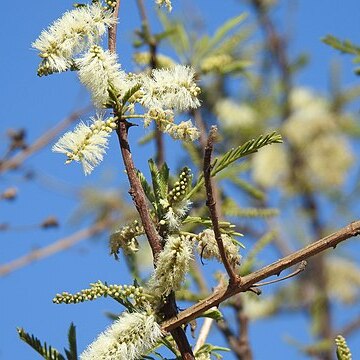Shrub or tree to 14 m high; trunk to 0.6 m diam.; crown often rounded. Bark reddish-or dark-brown to blackish, rough, frequently transversely and longitudinally fissured; young branchlets glabrous to sparingly or densely tomentose, eglandular or with minute reddish glands. Stipules not spinescent, in pairs, linear, 2.5-4 x 0.2-0.8 mm, soon deciduous. Prickles in pairs just below each node (rarely absent or with a few additional prickles scattered elsewhere on the stems), recurved or sometimes ± straight, dark-brown to blackish, up to 9 mm long. Leaves: petiole (0.5)0.8-3(4) cm long, adaxial gland variable in position, often slightly below the lowest pinna pair, 0.7-1.5 x 0.3-0.7 mm; rhachis (2)5-15(22.7) cm long, glabrous to densely tomentose, abaxial surface often with recurved prickles up to 3 mm long, with a gland at the junction of the top 1-3 pinnae pairs, occasionally between each pinna pair, or absent from some; pinnae (6)8-26(38) pairs; rhachillae (1.1)2.4-5(6.7) cm long, glabrous to tomentose; leaflets (13)21-50(64) pairs per pinna, 2-7(12.2) x 0.7-1.5(2.3) mm, linear to linear-oblong, apex rounded to subacute, glabrous to sparingly or densely appressed-pubescent below, margins with or without appressed or spreading cilia. Inflorescences spicate, solitary, fascicled or crowded into an irregular terminal panicle. Flowers yellowish-white, sessile; spikes (2)2.6-6.5(10) cm long; peduncles (0.2)0.8-2.5(4.1) cm long, subglabrous to densely tomentose, often glandular. Calyx campanulate, puberulous to pubescent or occasionally subglabrous or glabrous, tube 1-1.6 mm long, lobes 0.2-0.8 mm long. Corolla sometimes tinged with pink, puberulous to tomentose or occasionally glabrous, tube up to 2.5 mm long, lobes up to 1 mm long. Stamen-filaments free, up to 6 mm long; anthers ±0.15 mm across, with a deciduous apical gland. Ovary 0.5-1.9 mm long, glabrous or subglabrous, sessile or shortly stipitate. Pods light or dark brown, 4.5-19.7 x 0.7-1.5(2.7) cm, linear, straight or occasionally ± falcate, rounded to acuminate apically, longitudinally dehiscent, coriaceous, umbonate over the seeds, subglabrous or puberulous, seldom tomentose, with few to numerous reddish-brown glands scattered over the surface. Seeds olive-to light brown, subcircular to elliptic-lenticular, 6-12 x 4-8 mm, compressed; central areole 2-5 x 2-4 mm, horseshoe shaped.
More
A tree. It grows 14 m high. The crown is irregular and spreading. The trunk is often twisted. The bark is greyish-brown and smooth when young. It peels off in long strips. The branches have short, sharp, hooked thorns that occur in pairs. The leaves are bright green and droop. It loses its leaves during the year. The leaves are compound and feathery with many leaflets. The flowers are cream coloured spikes. The fruit are narrow, straight seed pods. The seeds are brown. They are small and flat.
Shrub or tree, 3-14 m high, trunk up to 0.6 m in diam. Bark dark brown, rough, transversely and longitudinally fissured forming squares. Branches glabrous to hairy when young, with or without minute red glands. Leaves drooping, bipinnate, rachis 50-150 mm long, pinnae 8-26 pairs, each with 21-50 pairs leaflets. Prickles 2, recurved, dark brown, up to 9 mm long. Flowers in spikes, 26-65 mm long, creamy white. Flowering time Sept.-Nov.
Tree or shrub, up to 14 m high; prickles in pairs just below each node, few, inconspicuous. Leaves with pinnae > 4 mm apart, giving leaf an open appearance; leaflets 0.70-2.31 (3.80) mm wide, 16-64 pairs per pinna; petioles 13-15 mm with rachis > 60 mm long. Flowers: inflorescence spicate; corolla yellowish white; Aug.-Dec. Pods linear, 45-197 x 7-15 mm, light to dark brown.
Tree or shrub, up to 14 m high. Prickles in pairs just below each node. Pinnae more than 4 mm apart, giving leaf an open appearance; leaflets 0.70-2.31 (-3.80) mm wide, 16-64 pairs per pinna. Pods linear, 45-197 x 7-15 mm. Flowers yellowish white.
Armed shrub or tree to 14 m, spines hooked. Leaves bipinnate. Flowers in cylindrical spikes, creamy yellow. Pods flat, constricted between seeds.


